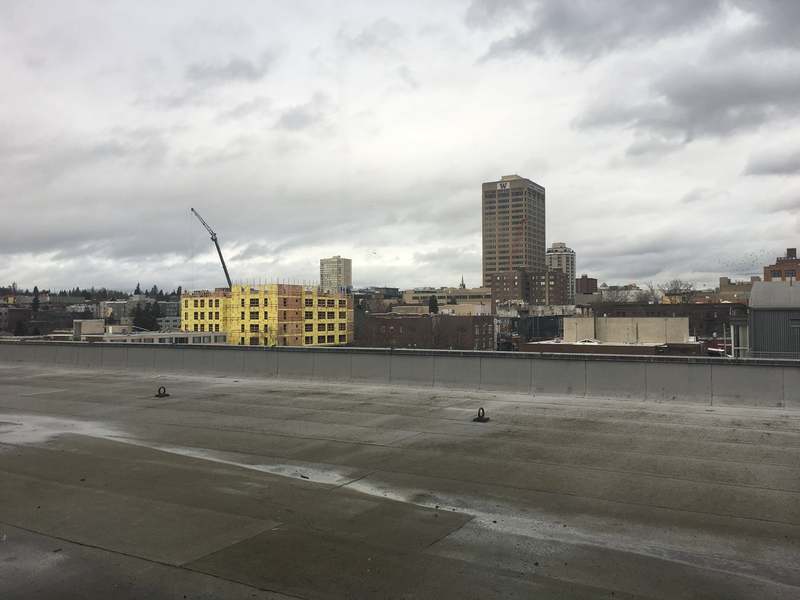Site Report 4

New apartments constructed in the last year a couple blocks west of block 29. VerveFlats; http://www.verveflats.com/; 2017.

A view facing north of the U District from the roof of Schmitz Hall. Photograph taken by author, 01/19/17.
Today, the U District mostly serves the population associated with the University of Washington (mostly students, but also some faculty, staff, and families on the peripheries). By land, it consists mostly of dense housing space for students living off campus. However, there is of course the locally-famous commercial region of the district referred to as “The Ave”. My block, directly below The Ave, has been owned by the University since the school’s relocation from downtown Seattle.
Going forward, the University District is changing rapidly. Just recently (February 21 2017), the city of Seattle rezoned the area to allow for significantly taller buildings (Beekman). A key document provided by the city, Urban Design Final Recommendations, describes the different regions of the University District and the design goals for each. The “core” of the University District is where the majority of changes will occur under the new vision for the area. My particular block, however, will not have its land affected by any new zoning laws; it narrowly escapes the region in the district describing The Ave. This is probably due to its current state: it has a large concrete building that is crucial to the operation of the UW. Although the building is noticeably old, it seems to serve its purpose perfectly well at the present. However, due to the fact that it is within feet of a rezoned area, the block will almost certainly be impacted in one way or another by new development. I expect, in the next decade or two, that the streets on the north and west of my block will lose their open-air feeling to larger buildings on either side.
In addition to the largest goal for the area (increasing affordable housing), the city hopes to improve streetscapes in the area. This is described in the document, Green Streets Concept Plan. The main objectives are to provide safe walkways, install good lighting for pedestrians, maintain/create bike lanes, increase greenery, and maintain some degree of parking for vehicles. It seems reasonable to expand benefits for pedestrians due to the advent of the new Light Rail station (Lindblom). This new mode of public transportation will ideally reduce the proportion of personal vehicles in the area and increase the proportion of pedestrians.
The ideas expressed in these documents are generally the views of city planners. They are clearly cognizant of the ongoing shift from a car-centric urban environment to a public transportation and bike centered environment.
It will be interesting to see the next developments of my block in particular. Although its current purpose seems crucial to the UW’s infrastructure, it could potentially be converted to additional housing space for students. Additionally, the building on the block could be completely rebuilt to be taller and house more administrative staff for the expanding university.
Works Cited
Beekman, Daniel. Seattle council approves big U District upzone; The Seattle Times; February 21, 2017; http://www.seattletimes.com/seattle-news/politics/seattle-council-to-vote-today-on-big-u-district-upzone/, (accessed March 2, 2017).
Henry Schmitz Drowns While on Hunting Trip, Seattle Sunday Times, January 31, 1965, P.1; Seattle Times Archives, http://infoweb.newsbank.com.offcampus.lib.washington.edu, (accessed February 22, 2017).
Lindblom, Mike. While transit use declines elsewhere, it’s booming in Seattle. February 22, 2017. The Seattle Times. (accessed February 25, 2017). http://www.seattletimes.com/seattle-news/transportation/while-transit-use-declines-elsewhere-its-booming-in-seattle/
"U District Green Streets Concept Plan."Seattle Department of Planning and Development and Seattle Department of Transportation. Web. 3 March 2017.
“Urban Designs Final Recommendation.” Seattle Office of Planning and Community Development. Web. October 6, 2016.
